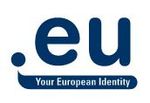.eu
 | |
| Type: | Non-Profit |
| Industry: | Internet |
| Founded: | 1999 |
| Headquarters: | Woluwelaan 150, 1831 Diegens |
| Country: | Belgium |
| Website: | www.eurid.eu |
| Key People | |
| Marc Van Wesemael, General Manager | |
.eu is the country code top level domain name (ccTLD) of the European Union. It is managed and operated by EURid, a non-profit organization founded by three registry operators: namely DNS Belgium, Istituto di Informatica e Telematica and Stiftelsen för Internetinfrastruktur (IIS), under the authority of the European Commission.[1]
.eu is considered the 9th largest top level domain name and the 5th most popular ccTLD worldwide.[2]
Background[edit | edit source]
In 1999, the eu was approved as the two letter-alpha code for the European Union by the ISO-3166 Maintenance Agency.[3] Subsequently, in 2000, the European Council endorsed the creation of the .eu TLD during its meeting in Lisbon to improve the electronic commerce within the European Union. On April 22, 2002, the European Parliament and the Council of the European Union enacted Regulation (EC) No 733/2002 ,which calls for the implementation of the .eu ccTLD to represent and promote the image of European community in global information networks.[4]
On May 21 2003, EURid was delegated by the European Commission as the registry operator of the .eu ccTLD in consultation with its member states.[5] On April 28, 2004, the European Union adopted the Policy Rules on how to implement the .eu ccTLD as a complementary domain name to the existing ccTLDs in Europe and other generic top level domain names (gTLD) for the purpose of increasing competition and providing alternative choice to Internet users in the region and to improve the interoperability of networks within the European region.[6]
The ICANN Board represented by its President and CEO Paul Twomey entered a Registry Agreement with EURid through its Managing Director, Marc Van Wesemael, to complete the delegation process of the .eu ccTLD in 2005. [7]
Sunrise Period[edit | edit source]
EURid implemented a four month Sunrise Period for the .eu ccTLD on a first come, first serve basis. It started on December 7, 2005 and lasted until April, 2006. During the Sunrise Period, the registry received more than 245,000 registrations.[8]
Landrush Period[edit | edit source]
On April 7, 2006, EURid opened the .eu ccTLD for public registration, known as the Landrush Period. According to EUrid, there was a strong demand for .eu domain names.[9] By June of 2006 .eu registrations reached around 3 million.
Bob Parsons, Founder and CEO of GoDaddy openly criticized the Landrush registration process implemented by EUrid and described it as a scam. According to him, some notorious companies found loopholes to the process and took advantage of the system. Parsons explained that some companies' modus operandi was, instead of registering as real active registrars, they created hundreds of new phantom registrars with similar addresses and contact information designed to hijack the .eu landrush giving the notorious companies greater opportunities to register domain names.[10] EURid Spokesman Patrick Linden denied Parsons allegations and explained that EURid validated the registrars that were accredited to sell .eu domain names.[11]
One month after EURid's denied Parson's allegations of abuse on the .eu ccTLD Landrush process, the organization discovered that three companies from UK namely Ovidio Ltd, Fausto Ltd, and Gabino Ltd, used syndicated registrars as fronts to acquire and stockpile thousands of domain names. This activity, known as warehousing, is not allowed, and EURid sued the registrars for breach of contract and froze more than 74,000 domain names that were allegedly stockpiled by syndicated registrars.[12]
IDN & DNSSEC Implementation[edit | edit source]
In December, 2009, EURid implemented Internationalized Domain Names (IDN) to allow members of the European Union whose languages use non ASCII characters in their alphabets; for instance the Swedish å, the German ü, the Romanian ș and other characters from the Bulgarian and Greek alphabets which uses accents, cedillas, and ogoneks.[13]
In June, 2010, during the 38th ICANN Meeting in Brussels EURid announced its deployment of DNSSEC to provide more security to its Internet users.[14]
Growth and Expansion[edit | edit source]
Based on Eurid's 2011 first quarter progress report, the organization implemented the Multiyear Registration program on April 7, 2011 allowing domain name registrants to register a domain name for a maximum of ten years. Currently, there are approximately 3.9 million registered .eu domain names. The growth rate of the .eu ccTLD registration compared to its 2010 figures is 4.2%. According to Eurid, Bulgaria (43%), Estonia (39%) and Romania (22%) displayed strong annual growth rates including a domain name renewal rate at 78%.[15] .eu is considered the 9th largest top level domain name and the 5th most popular ccTLD worldwide.[16]
References[edit | edit source]
- ↑ www.eurid.eu
- ↑ Europa.eu
- ↑ www.iana.org
- ↑ Regulation (EC) No 733/2002
- ↑ Designation of the .eu Top Level Domain Registry
- ↑ Implementation of the .eu ccTLD
- ↑ .eu ccTLD Registry Agreement
- ↑ Sunrise Period
- ↑ Fast Start for European Net Names
- ↑ The .EU Landrush Fiasco
- ↑ EU Denies .eu Landrush Abuse
- ↑ Thousands of EU Net Names Frozen
- ↑ .eu IDN
- ↑ www.internetblog.org
- ↑ 2011 Q1 Progress Report
- ↑ Europa.eu
